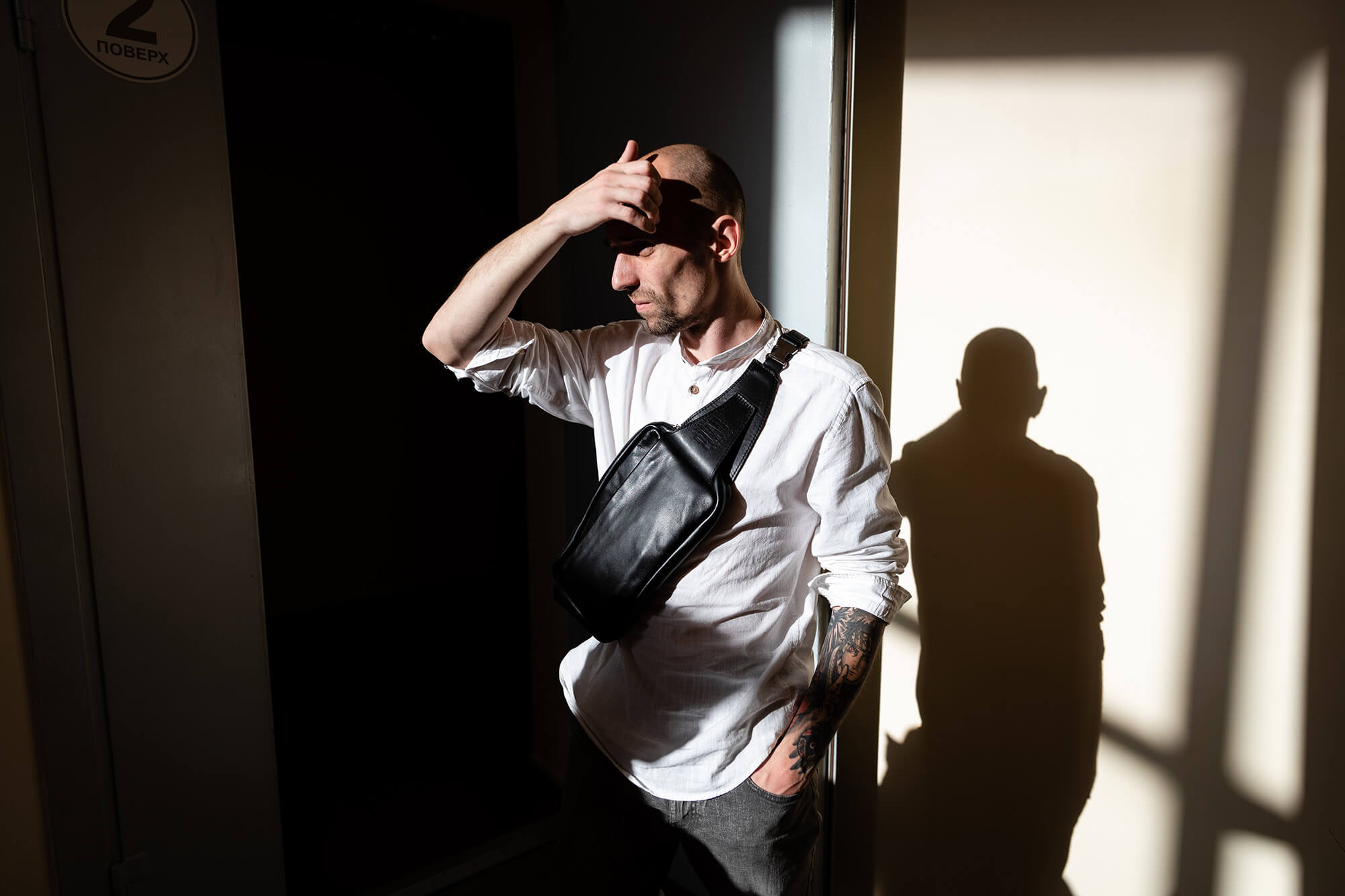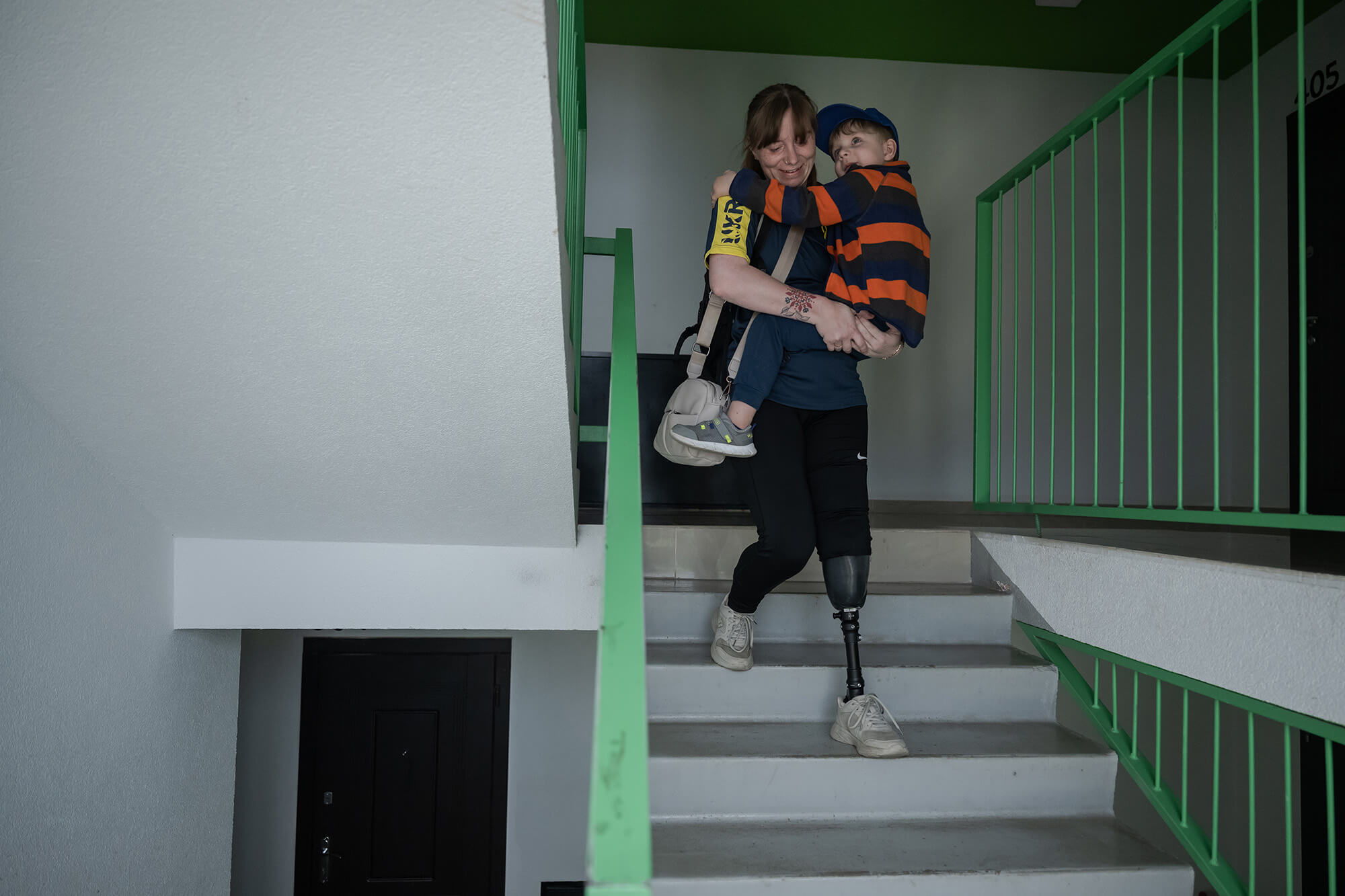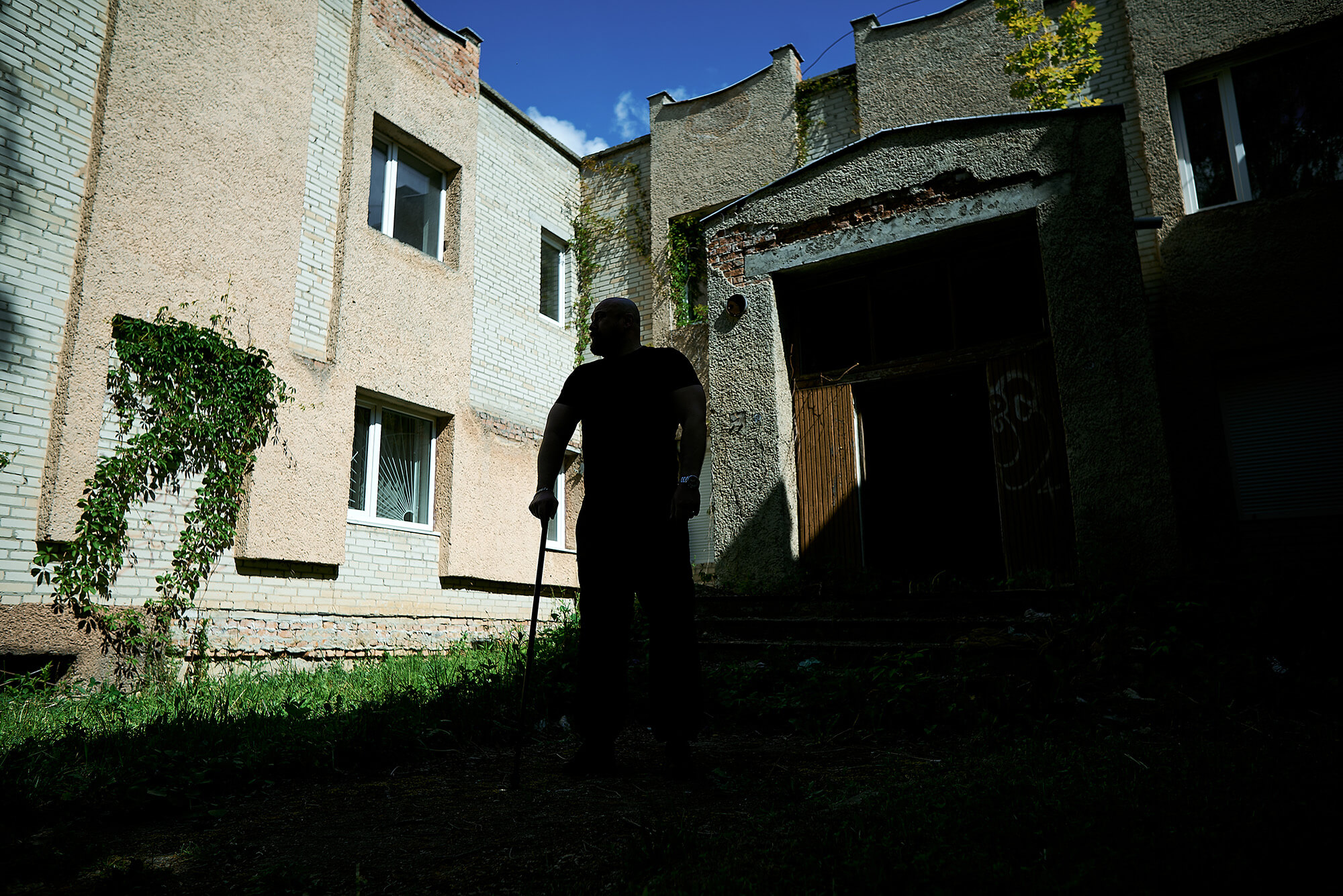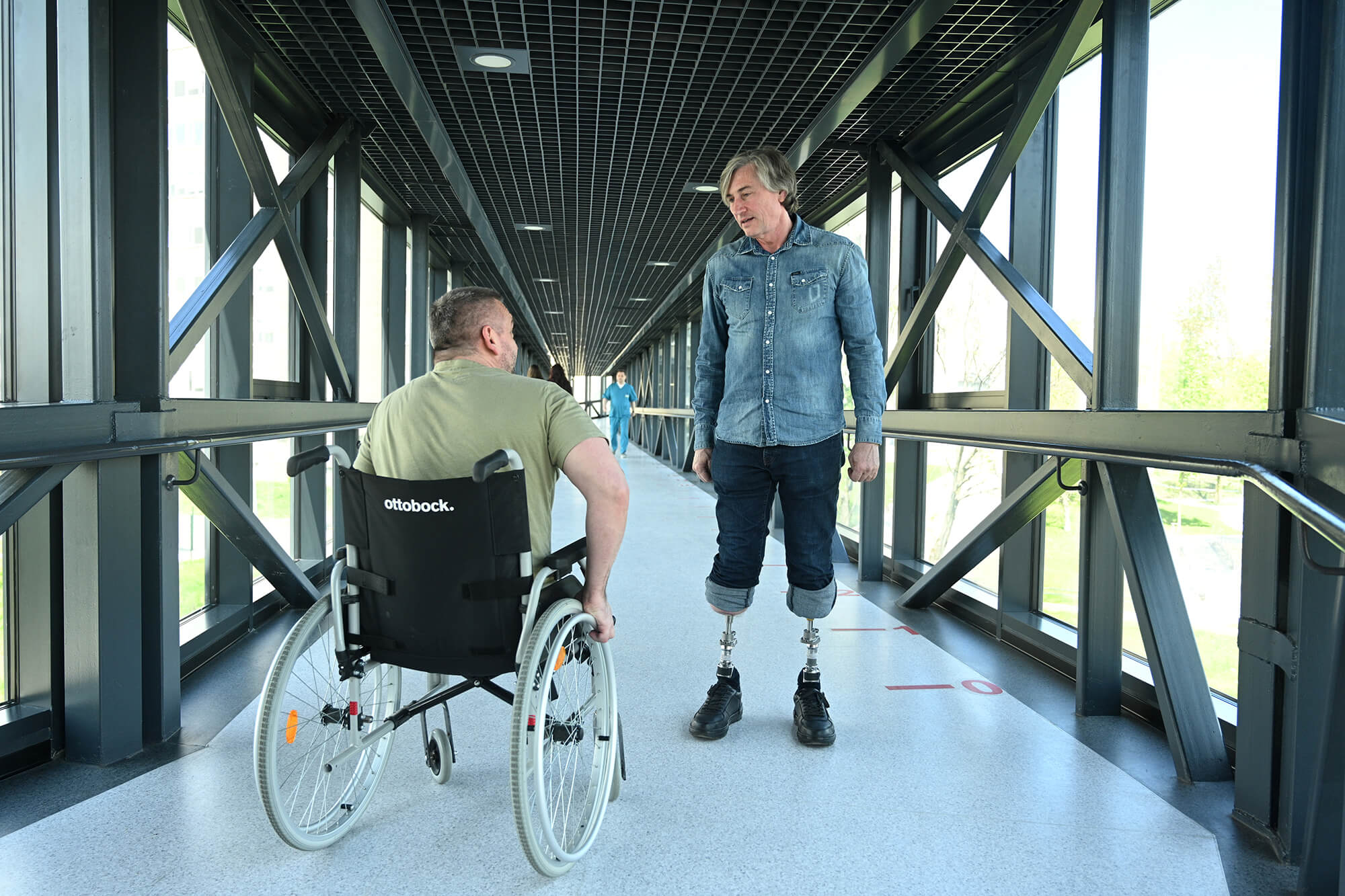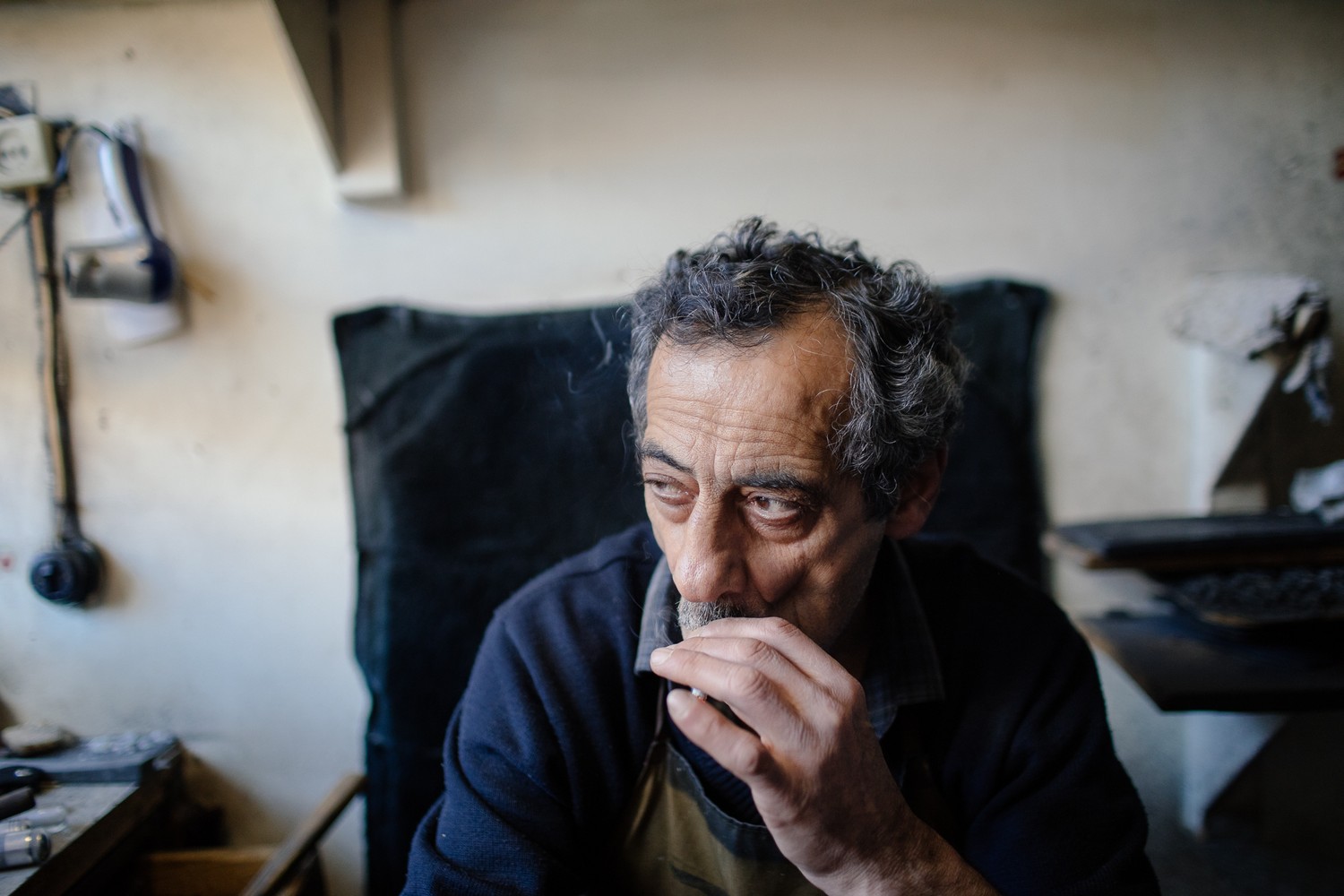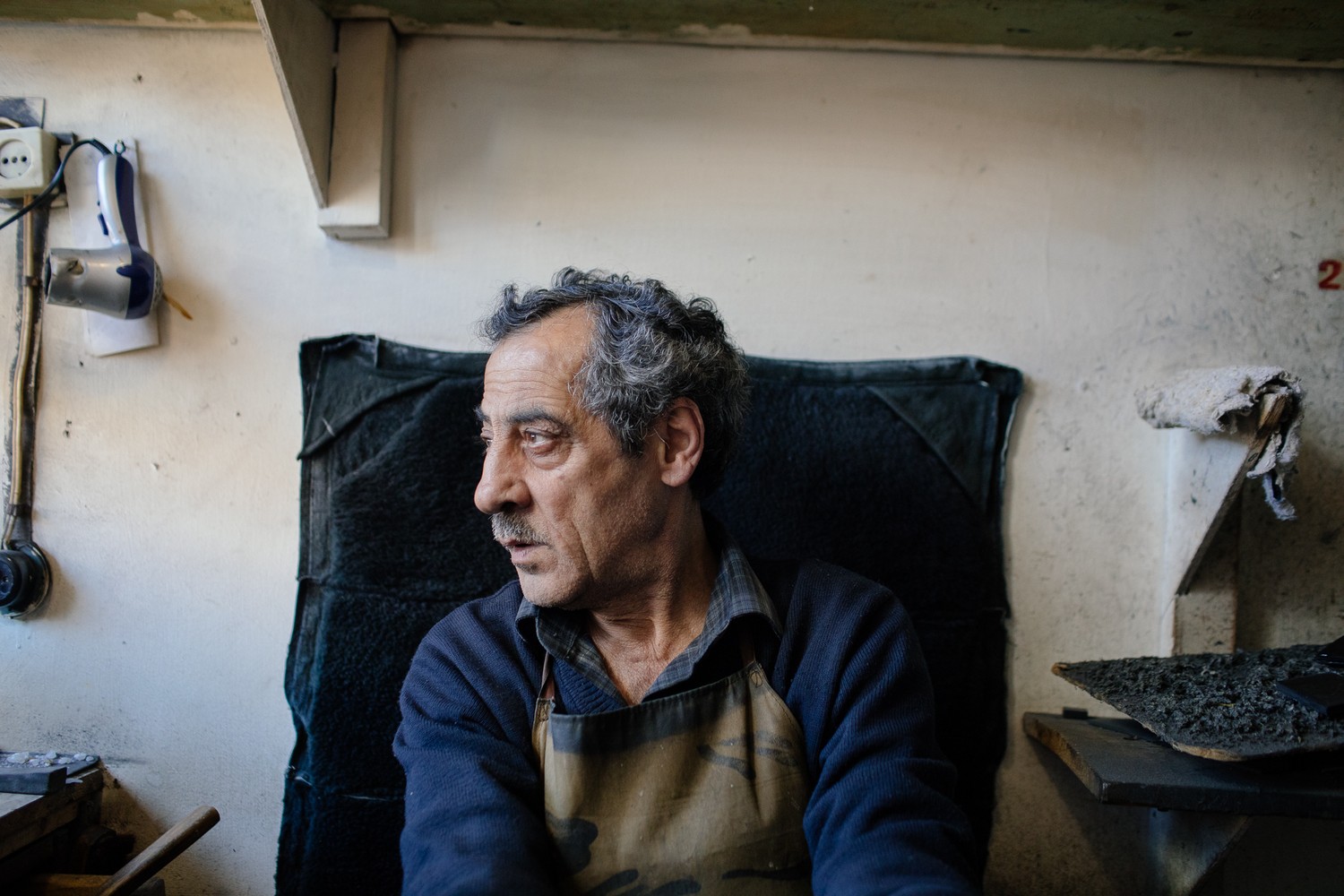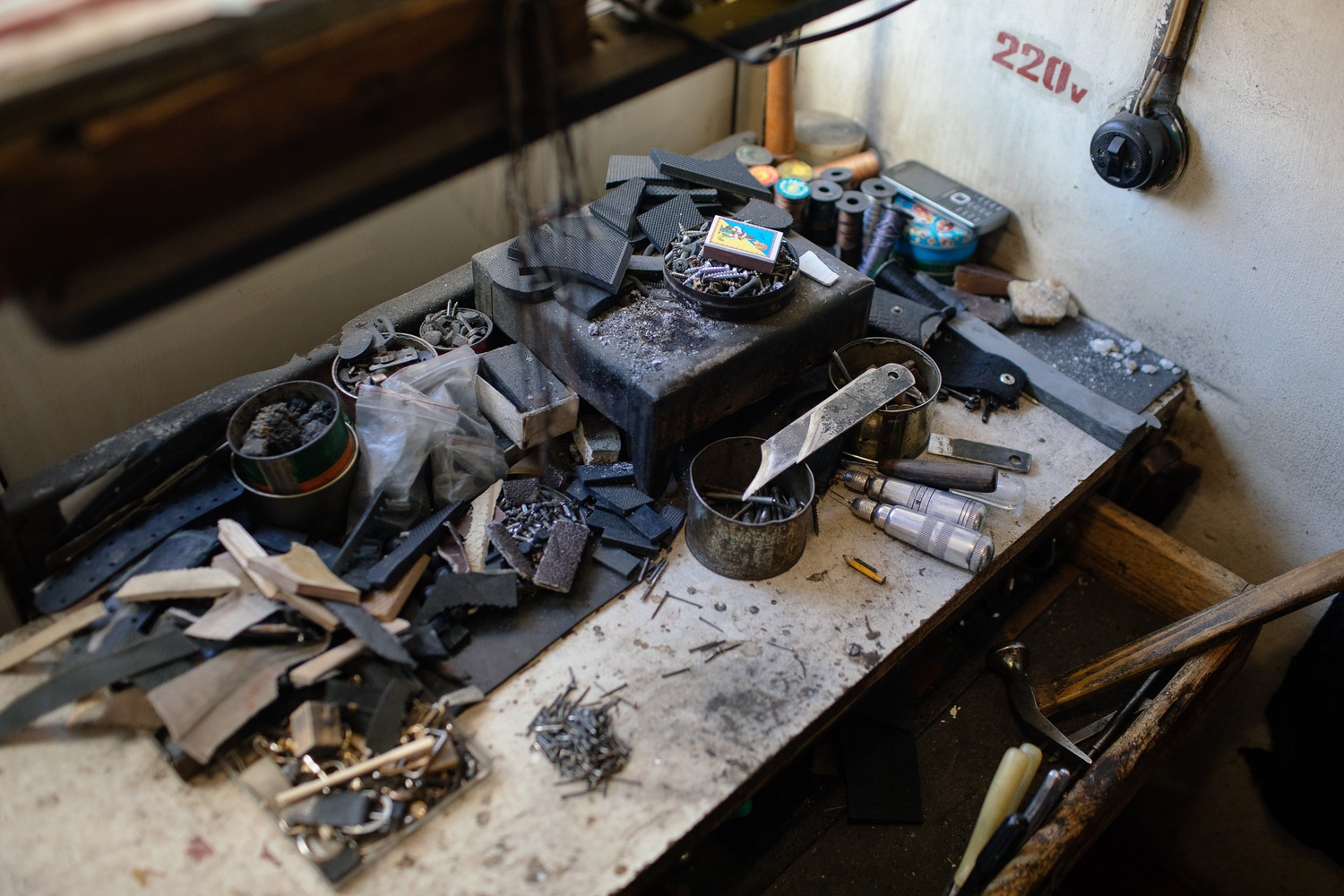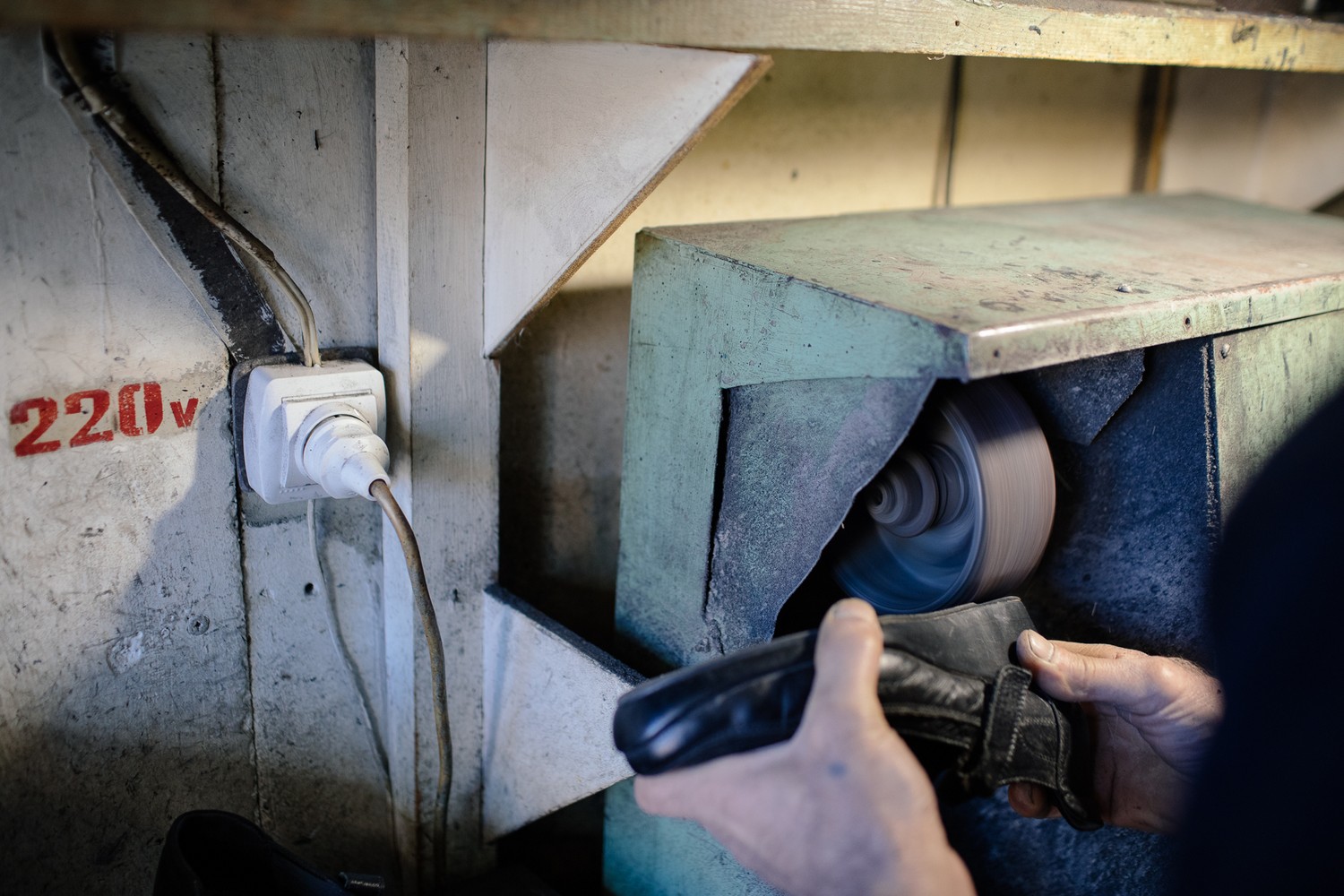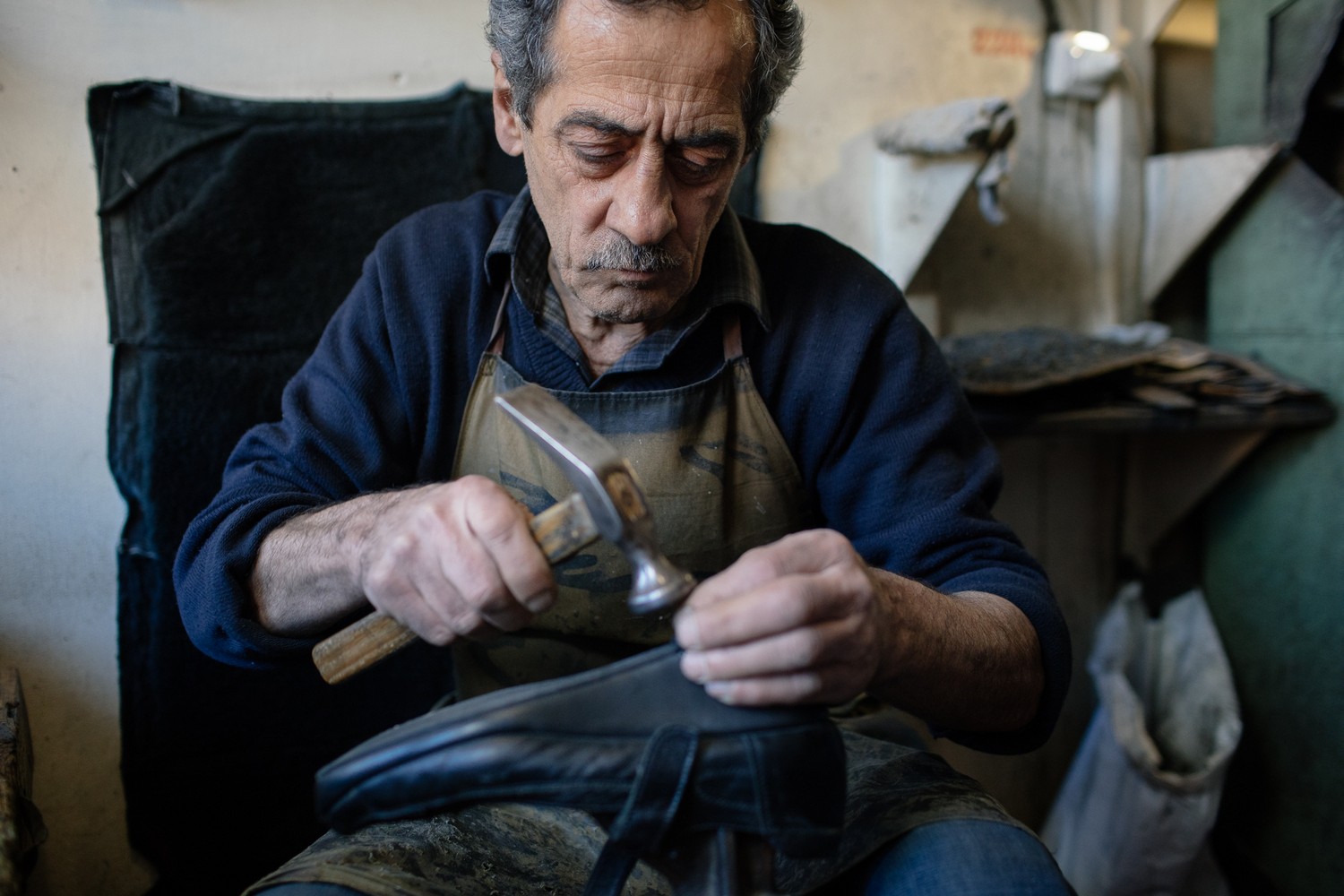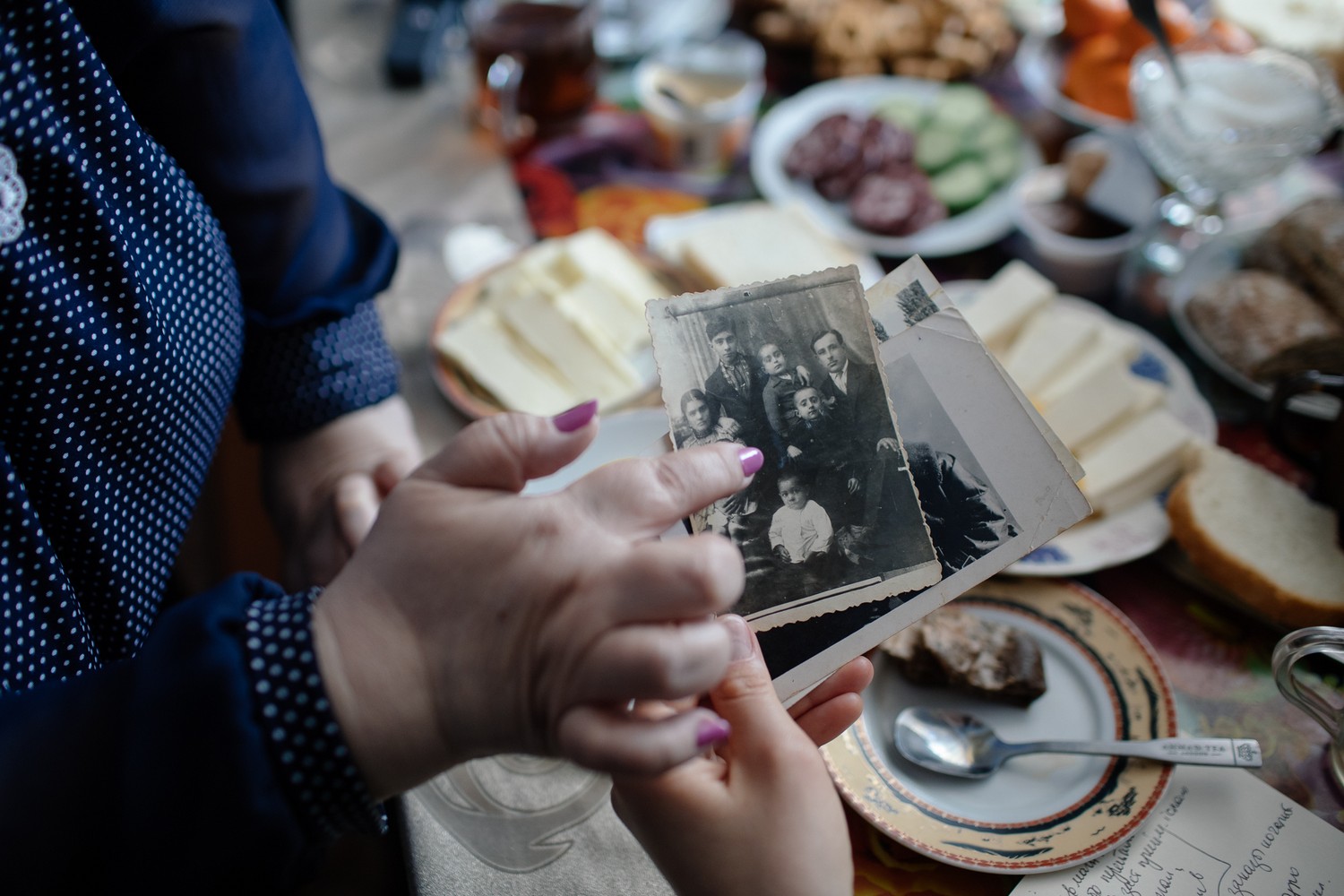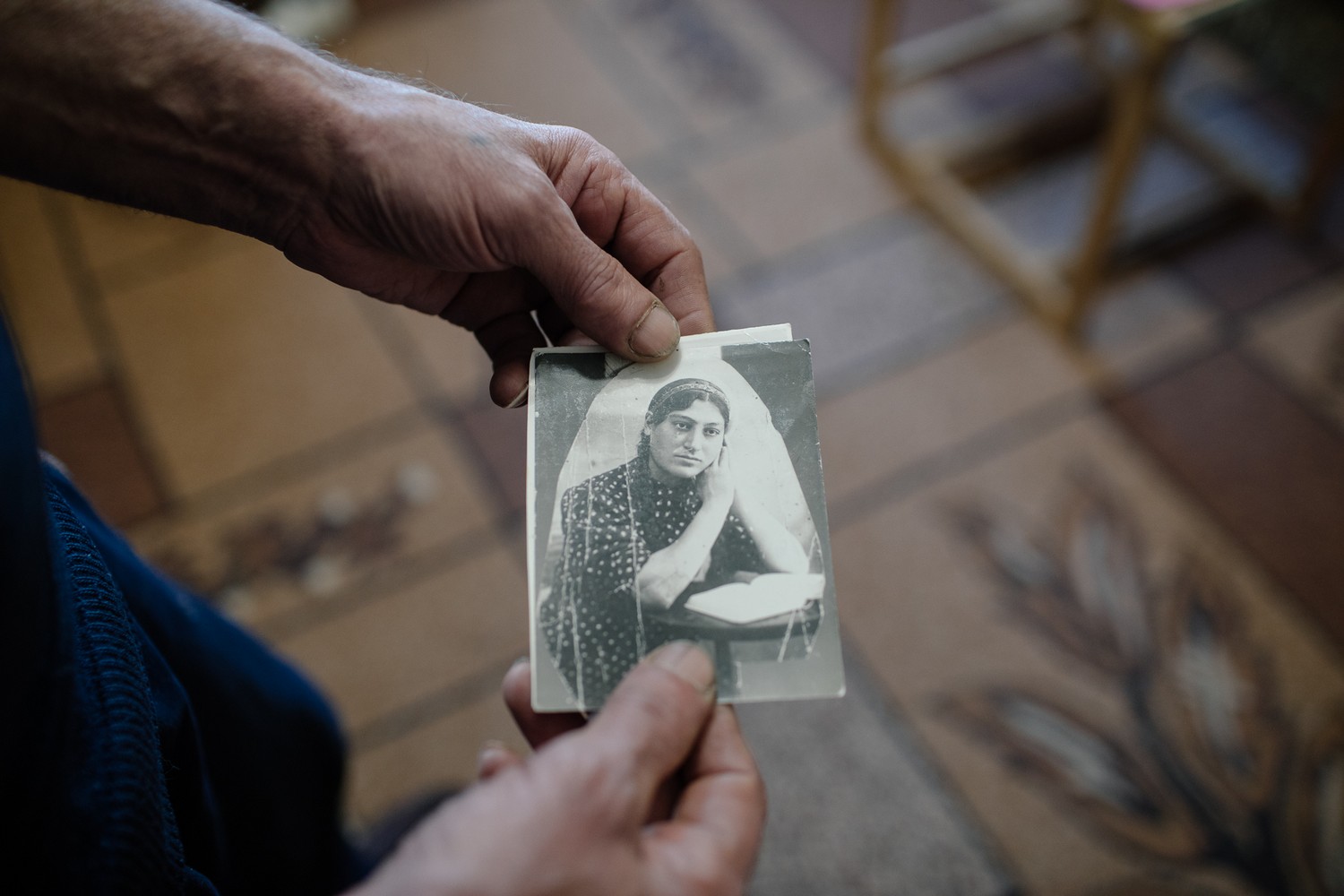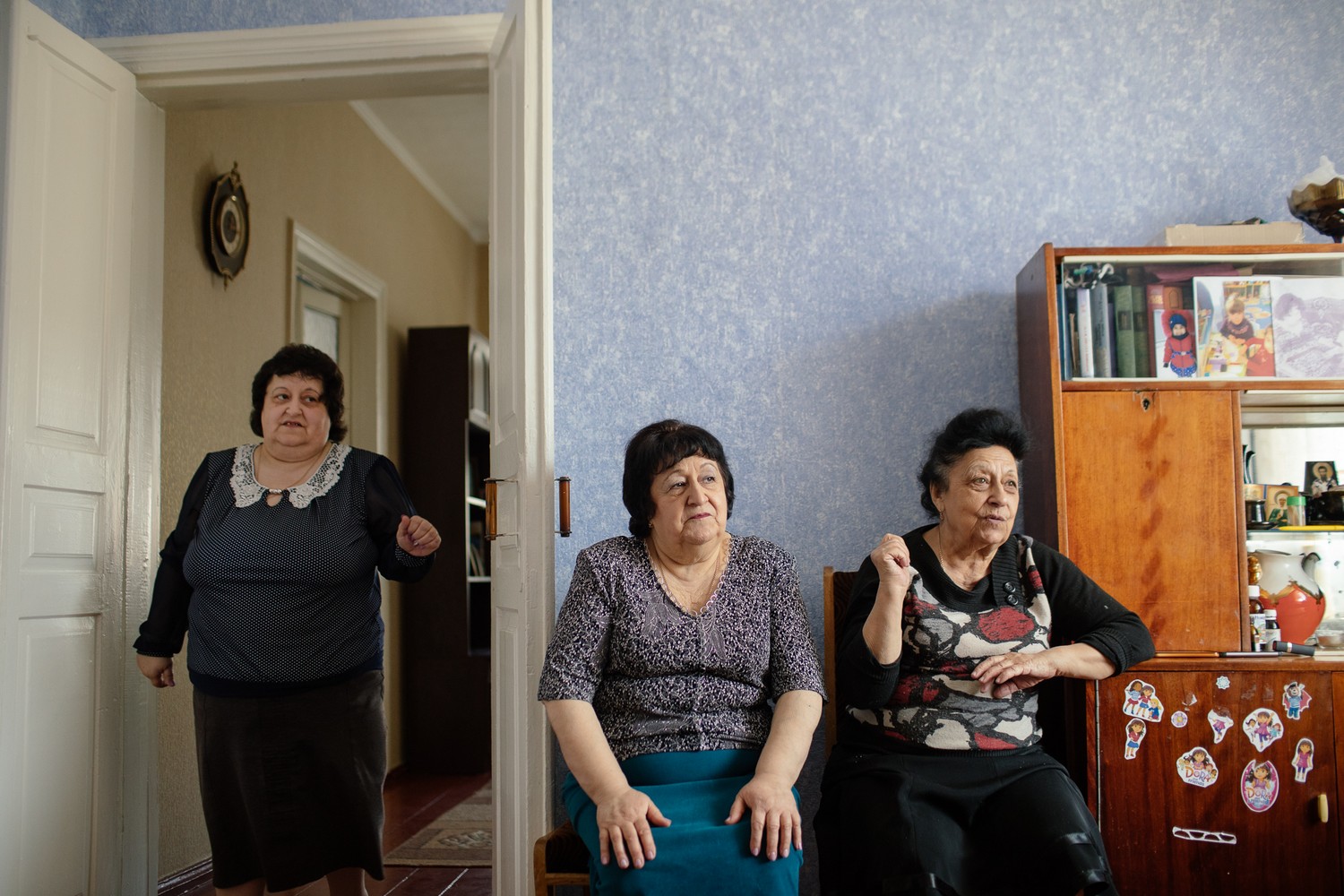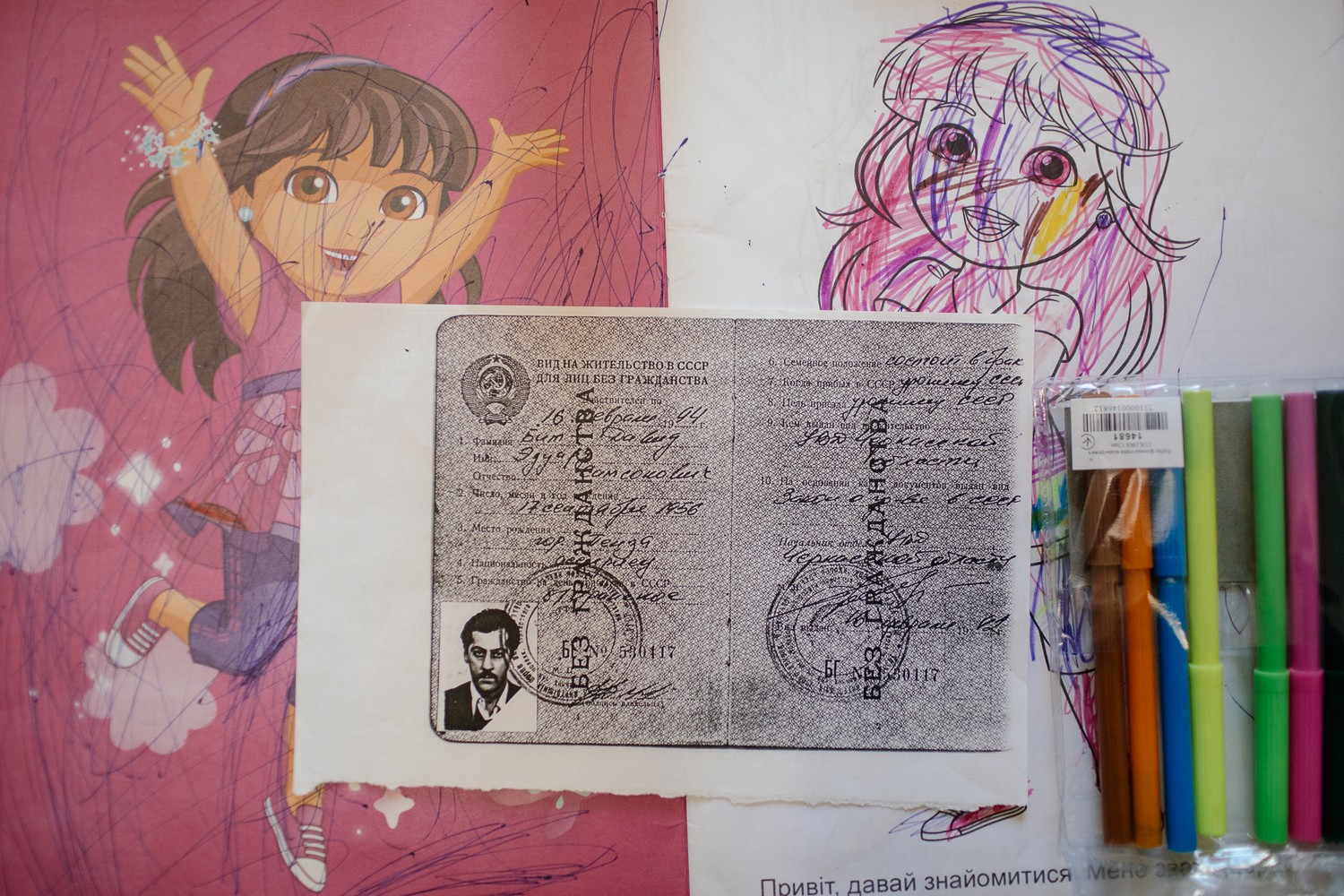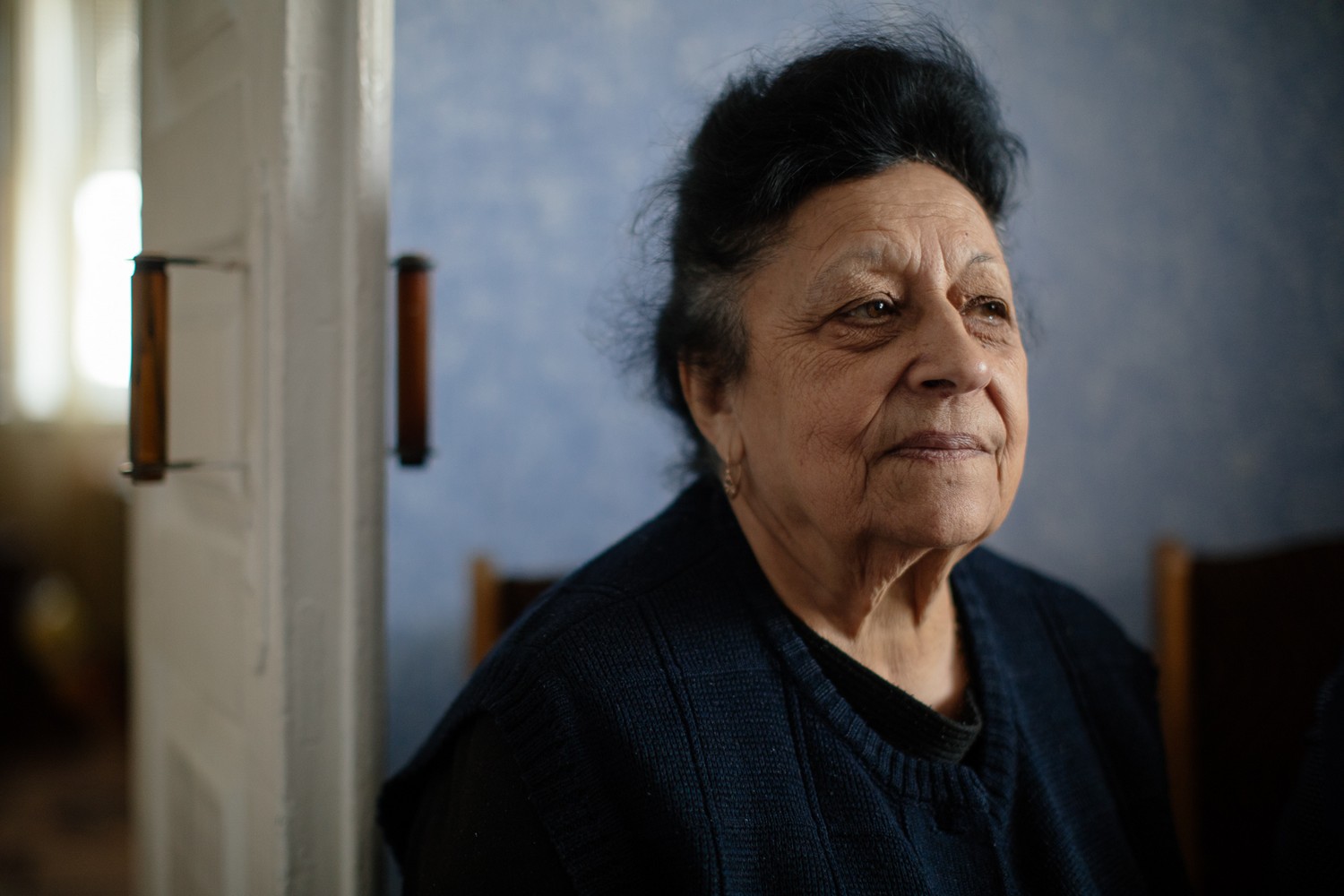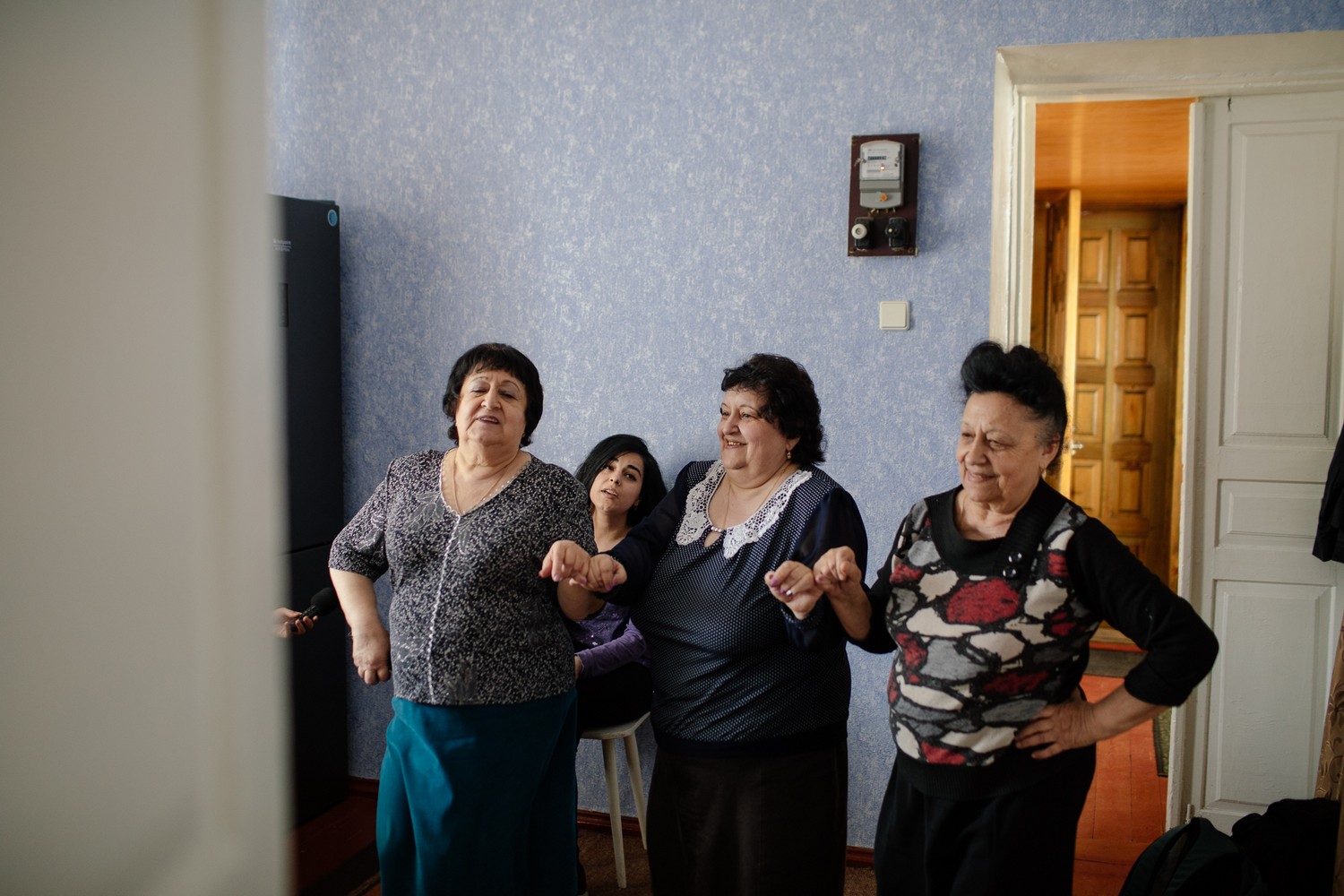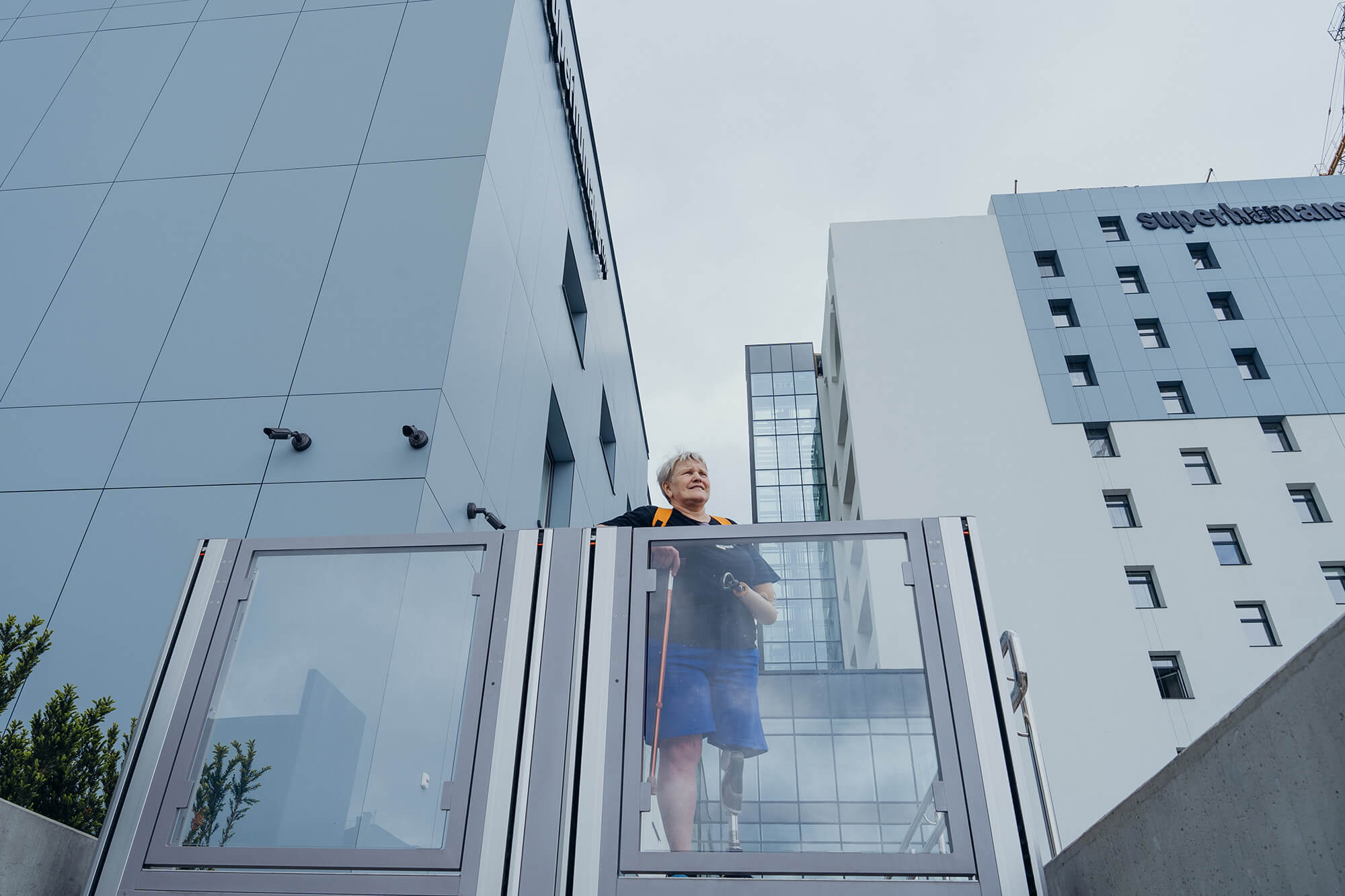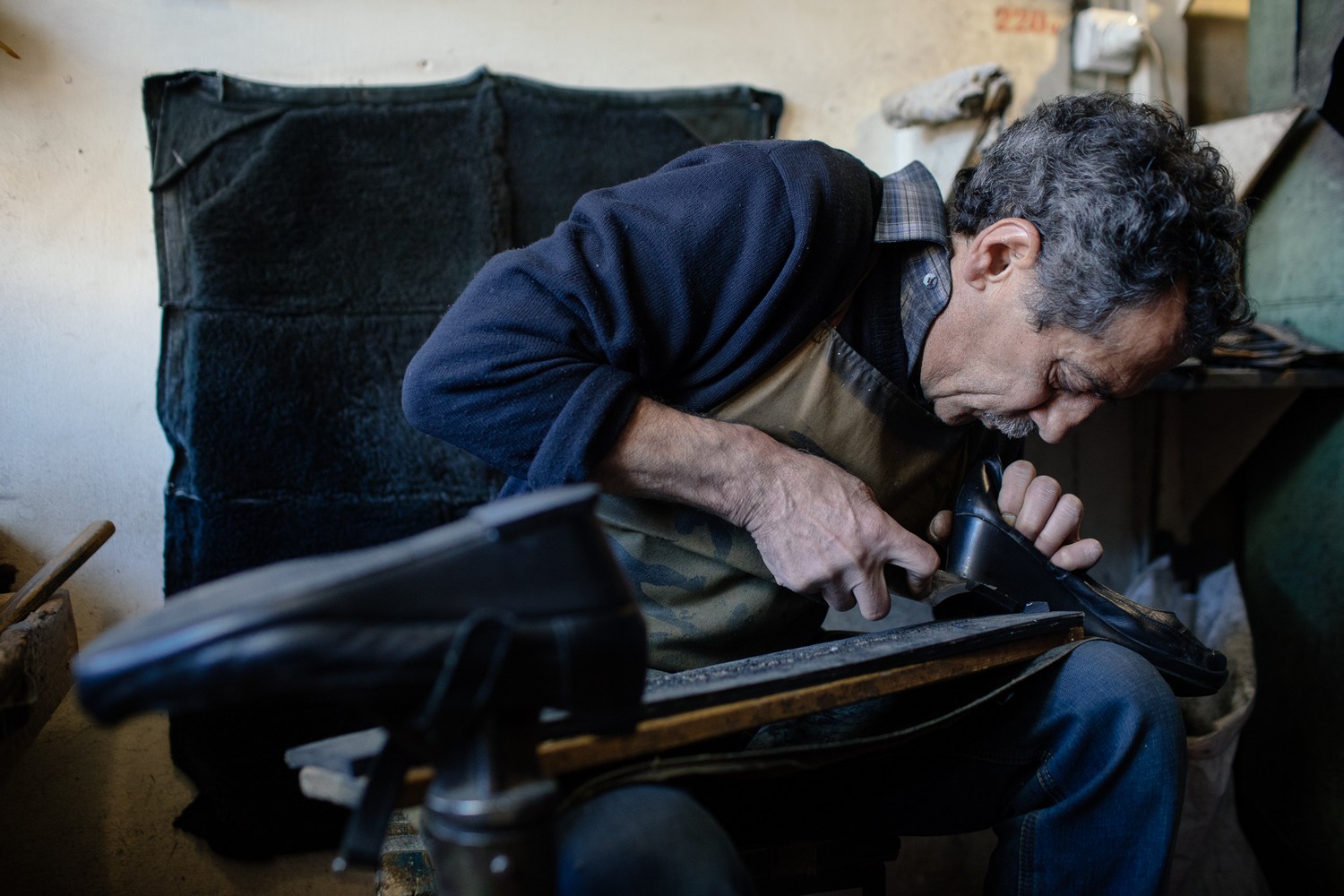
Born in Mesopotamia
Last summer in southeast Turkey, I found myself in an Assyrian church for Christmas services. Contemporary Assyrians consider themselves the descendants of Assyria, one of the most ancient civilizations on earth, whose history started four millennia ago in Ancient Mesopotamia. The mass was in Aramaic. This was the language (or one of its dialects) of Jesus Christ.
It later turned out that around three thousand Assyrians live in Ukraine. Their ancestors came more than one hundred years ago, fleeing the genocide of Christians in the Ottoman Empire. Their language is a contemporary version of what was spoken in Galilee at the start of our era.
Master
Assyrians are known today as masters of shoe repair. Ten years ago in the town of Zolotonosha in the Cherkasy region there were at least three shoe repair booths where Assyrian masters worked. Now only one is left—a narrow closet between two buildings, but at least on the main street. An elderly customer presents some old moccasins with a hole in the sole. The master—with a severe countenance, gray curls above his high forehead, and a cigarette in his hand—advises her to buy new ones. Not giving up, the old woman takes a pair of children’s canvas sneakers out of her purse. It’s the same deal—they are beyond repair.
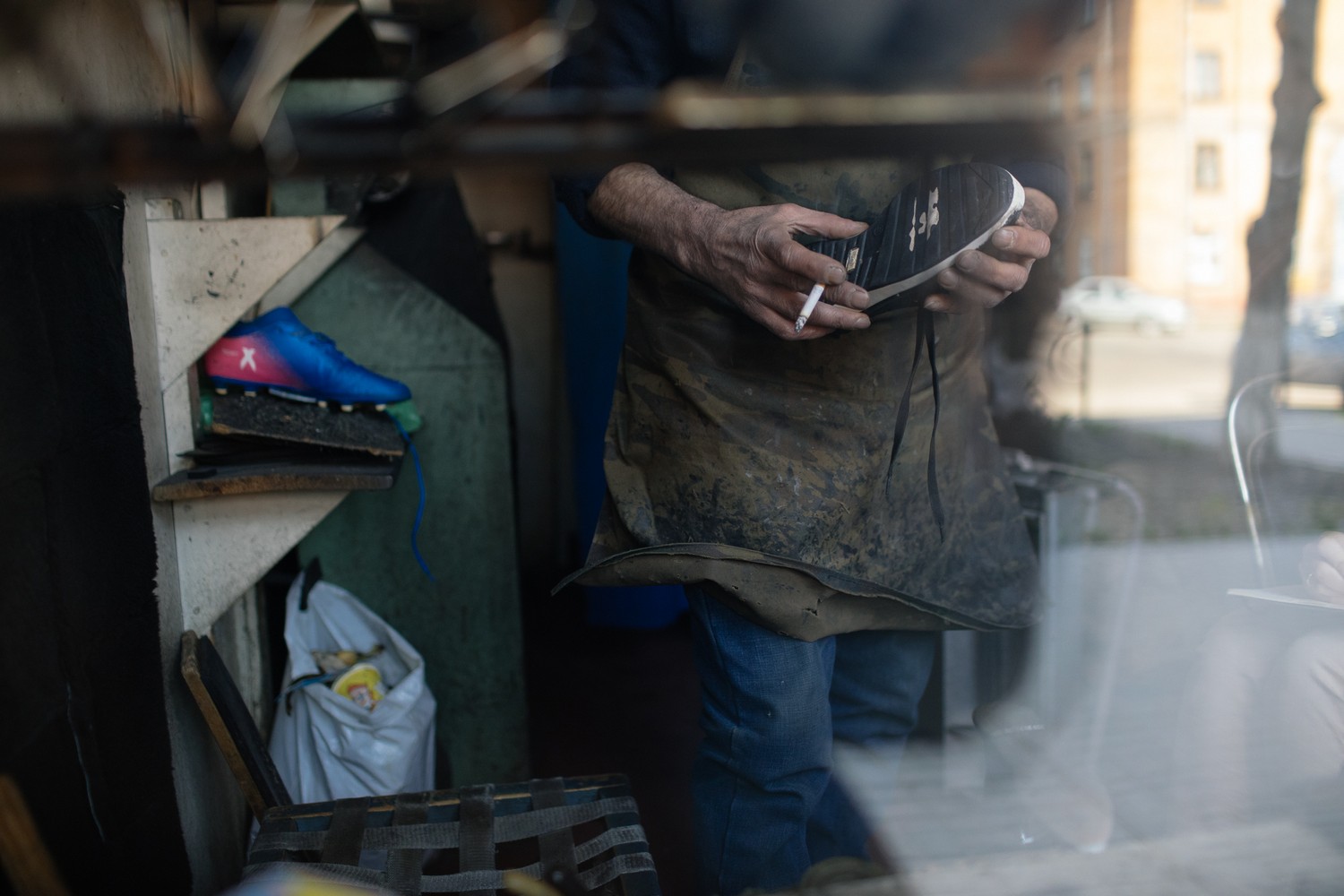
The master’s name is Eduard Bit-Davyd. His daughter later tells me that Assyrian last names start with Bit: beta means “house,” so he’s Eduard “from the house of Davyd.” Often these last names are Russified and turn into Davidovs, but for now:
“Honey, there aren’t any Assyrians.”
“What do you mean?”
“I grew up in Russia. I was embarrassed when my parents spoke their language. What kind of Assyrian am I?”
Eduard grows quiet and leans on the shelf with the samples and lights his cigarette. Then he starts on the next shoe. I drive out the thought that I came to Zolotonosha for nothing. I wanted to see the last Assyrian cobbler and here you go: there aren’t any Assyrians.
In looking for information about this people (they call themselves Syriacs or the Atoraya), I came across an article about the history of the Bessarabsky Market. In the comments someone had written that he remembered the post-war Bessarabsky district as “basements inhabited by Assyrian shoe shiners whose abundant booths stood the length of Baseina Street.” Even before the war, in the 1920s, nine out of ten Kyiv shoe shiners were Assyrian. First they polished them, and then begin to repair and even sew the shoes.
They lived in the city center, closer to their work. They were already city dwellers, but they couldn’t seem to shed their agricultural habits. One hundred years ago, Kyivites passing through St. Sophia’s Square could see Assyrians carrying sacks of wheat, winnowing the grain in the wind, rinsing and drying it on thick runners spread out right there. “All day until the sun went down, they would sit near that wheat, driving away sparrows. The old ladies would sew and the old men would smoke their pipes and look thoughtfully, perhaps recalling their far-off Urmia and Mesopotamia,” local Ukrainian historian Fedir Bakhtynsky wrote in his ethnographic notes for the journal Skhidnyi Svit (Eastern world). The year was 1928.
The first Assyrians started leaving the Ottoman for the Russian Empire back in the 19th century for seasonal work. The land back home was insufficient to feed their families. But during World War One when the Turks committed genocide against Christian peoples, Assyrians began fleeing en masse for Russia. For a people that adopted Christianity in the 1st century, it was natural to look for protection in an Orthodox state.
Someone got the idea of shining shoes, for which you don’t need any special skills. Later they realized that they could fix them too. And sew. One brother started; others followed. Slowly Assyrians gained a monopoly on this trade in cities
So how did dirty sidewalk work become the main source of income for these former peasants? Despite their shared faith, Assyrians did not know Russian. The land they could have lived off of, they didn’t have. Someone got the idea of shining shoes, for which you don’t need any special skills. Later they realized that they could fix them too. And sew. One brother started; others followed. Slowly Assyrians gained a monopoly on this trade in cities.
In the USSR in the 1920s, an order was even issued to set aside shoe shining and repair for Assyrians—evidently they already formed a majority. Assyrians started uniting in companies with beautiful names like Star of the East.
Reconciled to bidding farewell to the last Assyrian cobbler in Zolotonosha, I noticed an Assyrian flag drawn on the wall of the workshop that smelled of glue. In the center of a white field is a four-pointed star from which emerge wavy blue, white, and red lines. These are the three main rivers of Assyria: the Euphrates, the Great Zab, and the Tigris. I point it out to the master. 62-year-old Eduard Bit-Davyd shrugs me off—I need to talk to the old people, not to him.
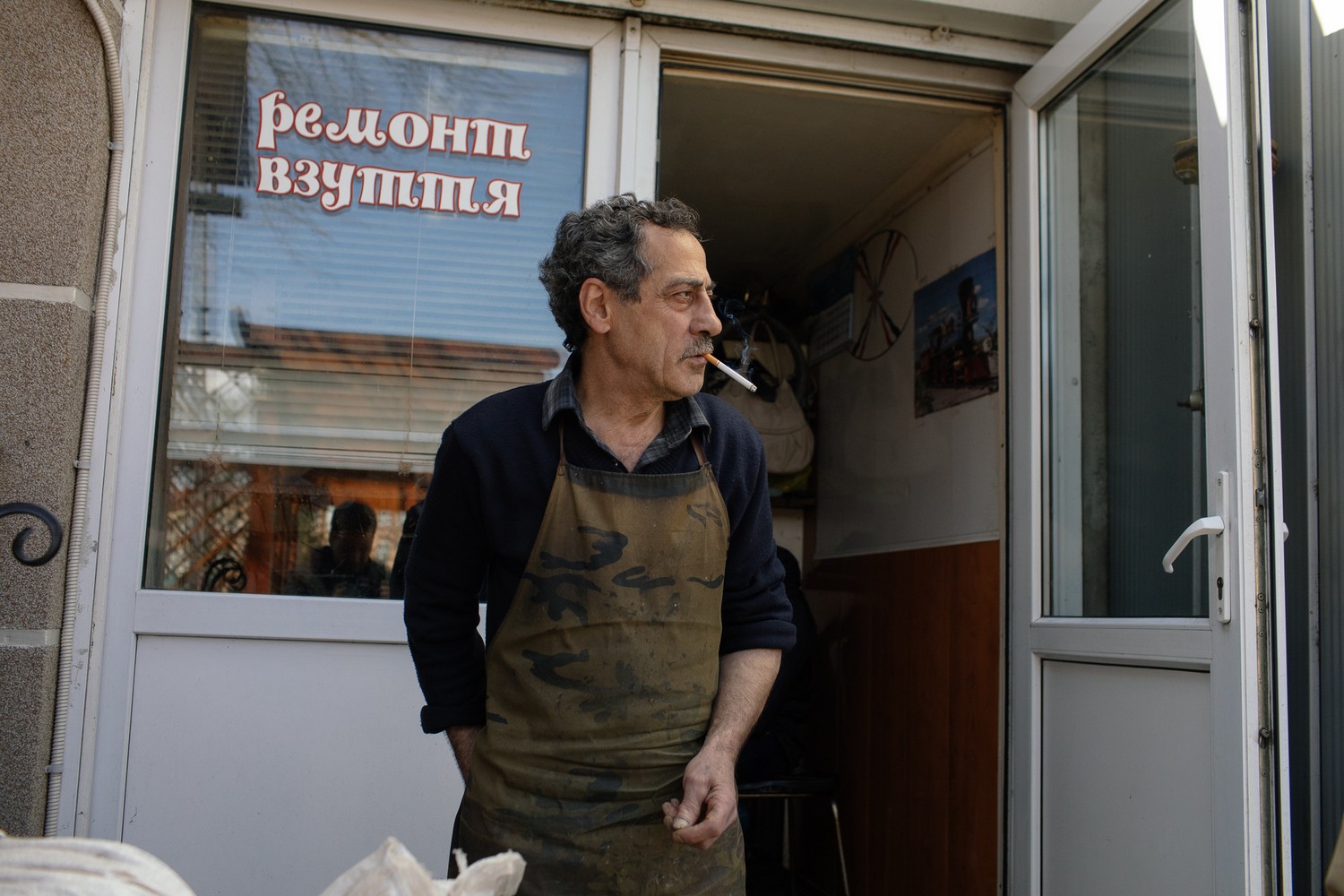
The Year 6769
I failed to meet any Assyrians older than Eduard in Zolotonosha, but I saw some Assyrian women. The women proved more talkative and they invited me to their homes.
“Pay no attention if our house isn’t very clean,” Anna, Eduard’s wife, excuses herself. Her loved ones call her Annushka.
“This is nothing. Remember the dust when we were sewing slippers!” says her older sister Larysa. She’s Lialia.
The sisters lead me to their home, which was built by their late father Varda Kisanov (it should be “Bit-Nisan,” but the capital N was taken for a K—this is how the Russified surname of the Soviet family was born). I can see nothing “Eastern” inside except for perhaps a mug with the Assyrian flag in the china cabinet. Souvenirs like this are made for the celebrations of the Assyrian New Year which comes in early April. It is currently the year 6769.
We are joined by a third sister, Zina, and the women call me to the table where vegetables, cheese, and boiled lamb—bysra—soon appear. The sisters cook all together.
Their father Varda, the oldest son in his family, arrived in Zolotonosha from Pryluky with his wife Mariam in the 1950s. They settled there because there weren’t any Assyrians in town yet—Pryluky was home to quite a few and they all worked in shoes: they repaired them and sewed slippers, felt valianky boots, and shearling chyni booties. The younger ones followed their older brother into Zolotonosha, where there wasn’t any competition.
The brothers got married, and then so did their children, and sons- and daughters-in-law came to the city. This is how the community grew. They usually tried to marry within the community, but there were no prohibitions against marrying locals. Larysa, the oldest, married a Ukrainian. The youngest, Anna, married an Assyrian from the Russian city of Penza, that is, Eduard. And Zina found herself a husband from the Assyrian village of Urmiia in the Kuban.
Assyrians in Zolotonosha have continued cobbling, some after going to school. Larysa, 72, recalls that the head of the local daily-needs enterprise was one of her uncles, Yurii. Unlike his self-taught older relatives, he graduated from the Kyiv Technicum where he studied shoe technology (and later compiled a short Russian-Assyrian dictionary). Her father Varda worked with him as a shoe repairman.
“They made fashionable women’s shoes that you couldn’t tell apart from store-brand ones, but oh how strong they were!”
They sewed the shoes at home and sold them at the local bazaar. They’d throw the sacks on their backs and off they’d go, the sisters recall. The women cut the material either from new fabric or from old military greatcoats or overcoats, and the men sewed it. They would rise at 5 o’clock in the morning and work until dark. The kids woke up and fell asleep to the sound of the sewing machine.
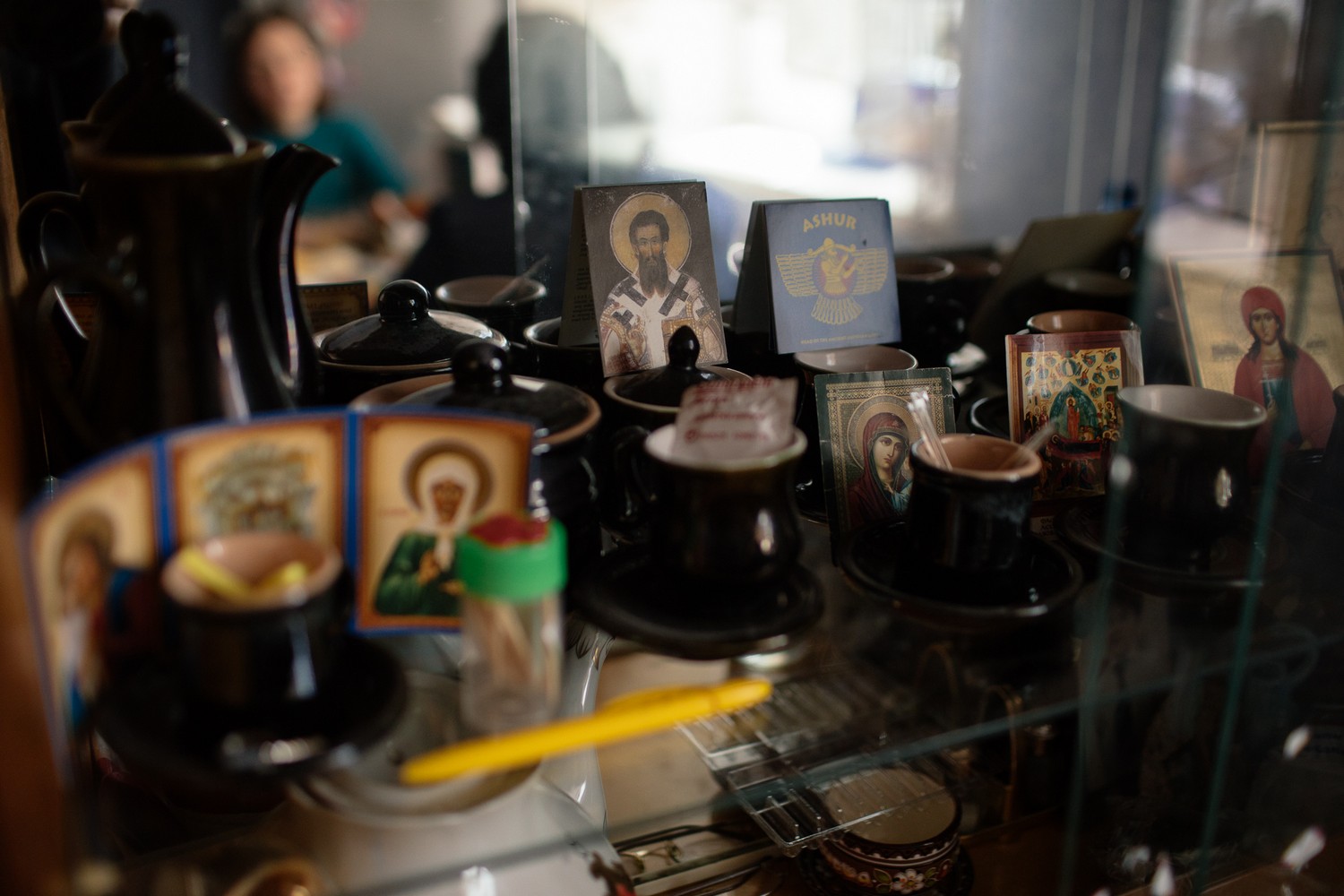
When the enterprise went the way of the USSR, the brothers were already working in their own shoe repair shops. Varda Kisanov opened his own on two meters of available land between a deli and the neighboring building on Zolotonosha’s main street. When he died, the family was at a loss—traditionally women don’t sew, but he had no sons. Should they sell it? But there was another son-in-law.
“Edik wouldn’t let us sell it. He said, ‘Maybe someday we’ll need to earn our daily bread again,’” Larysa recalls.
When he first worked there, Eduard would just sit in the workshop doing crosswords and handing out the shoes. At that time he didn’t know how to sew for he had only worked as a machinist for the railroad. But he learned quickly. And in the 1990s it at least offered some kind of work. And now he’s been cobbling for over 20 years.
Punished
Annushka pours the tea, and instead of meat and vegetables, she brings candies, cookies, and marmalade. I promise to drop in on the other two sisters for lunch as Eastern hospitality demands.
Eduard tests me with bloody stories about ancient Assyrians and his own grandfather and great-grandfather. He raided Muslims and brought home a leather sack full of human ears. He shook them out onto the floor and ordered his sons to make pairs. This was how they raised warriors. God probably punished the Assyrians for their cruelty, Eduard concludes.
How did he punish them? First and foremost by making them lose their state. Over 100 years of life with Christians, Assyrians have assimilated more than in their 2000 years among the Muslims in the Near East. Today, post-Soviet Assyrians feel closer to Russians or Ukrainians than to their tribespeople from Iraq or Turkey. Ruined by Stalin’s repressions, they barely know their own language, much less how to write it.
Sitting around the table, someone recalls the words of they think Churchill: “When you see an Assyrian, doff your hat, for you’re meeting history”
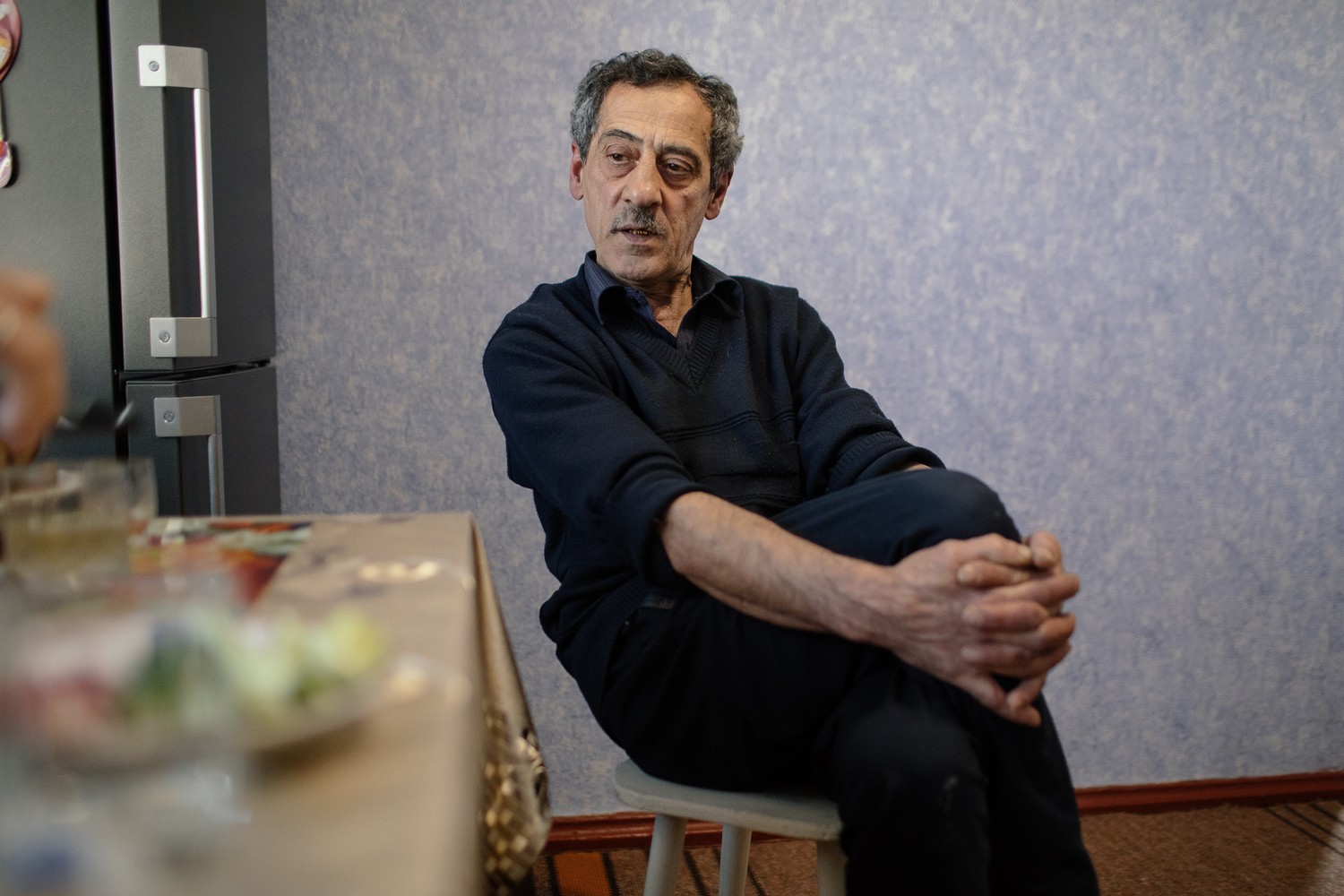
Eduard’s dad was in jail for 27 years. Entire families were loaded up into wagons and taken off to Kazakhstan. His father told him about the cold and 300 grams of bread per day. One day, his aunt, who was then just a child and cried very hard from hunger, was just left in the cold: “she froze like a snowman.”
Some perished in Kazakhstan, some in the Urals, some in Siberia. Some people, like Eduard’s dad, managed to return. However, Assyrians understood that it was best not to draw too much attention to themselves, which is why they didn’t teach their children their language. When they were little, their father told them fairy tales and Bible stories in Assyrian; as they grew up, the adults spoke in their language when they wanted to keep something a secret.
“If I knew the language, maybe I’d think differently,” Eduard says bitterly.
In the first decades of the USSR, Assyrians often didn’t have Soviet citizenship. The first generation of emigrants secretly kept their Iranian passports and set aside money for the trip home to Iran. Seeing the devastation there, they often returned to the USSR. They didn’t always cross the border legally: they would just walk into Iran like they were going to the bazaar. In 1938 all Assyrians, Soviet citizens and Iranian subjects alike, were accused of spying and sabotage.
The “son of an enemy of the people,” Eduard lived his whole life in the USSR with a certificate for individuals without citizenship even though he was born in the country. It was difficult for him and his brothers and sisters to go to school or find work. He only got a passport in 2000, by then it was Ukrainian.
Temple
Sitting around the table, someone recalls the words of they think Churchill: “When you see an Assyrian, doff your hat, for you’re meeting history.” The tea has been drunk and the cookies and candies are cleared to make room for books and newspapers. Eduard has many years of the newspaper Khabre d’aturai (Assyrian news), which is published in Zaporizhia, sewn together. He also brings out a stack of books on ancient Mesopotamia. His nephew, the Kyiv priest Volodymyr Kostochka, collected this library.
Besides the religious holidays they share with Ukrainians, the next most important event of the year for Assyrians is Temple. That’s what they call the feast day when every family honors its saint. Since the times of Persia, this is perhaps the strongest link in Assyrian tradition, tempered by the fire of Soviet atheism. “You can reject your bread, but never the temple,” Assyrians say.
In the USSR, it wasn’t forbidden to honor feast days. Perhaps it was because the incomprehensible names of the holidays weren’t connected to religion: Mar Gewargis, St. Gregory’s Day; Mar Tuma, St. Thomas’s, Sharet Mat Mariam, the Feast of the Dormition. As Father Volodymyr explains, though, these holidays had practically lost all traces of religion. Although there is supposed to be a family icon, the main activity happens not in a church, but at home or at a restaurant. This is a great feast with folk music and dancing. Even the Assyrians’ neighbors love these holidays and they go out onto their balconies to watch the exotic spectacle.
Temple is an important part of upbringing: this is where children learn about traditions and hear their native tongue. Young Assyrians mostly speak Russian or Ukrainian, but when they hear “shlamalakh”—an Assyrian greeting—on the street, they jump for joy. It is mandatory to order cakes in the colors of the Assyrian flag for weddings. The flag is also cell phone backgrounds.
They say that the blue, white, and red waves of Assyria’s three rivers symbolize the roads Assyrians from all corners of the globe will take to get back home. The Assyrian state ceased to exist in the 7th century BCE. More than two thousand years later, Assyrians remember who they are.
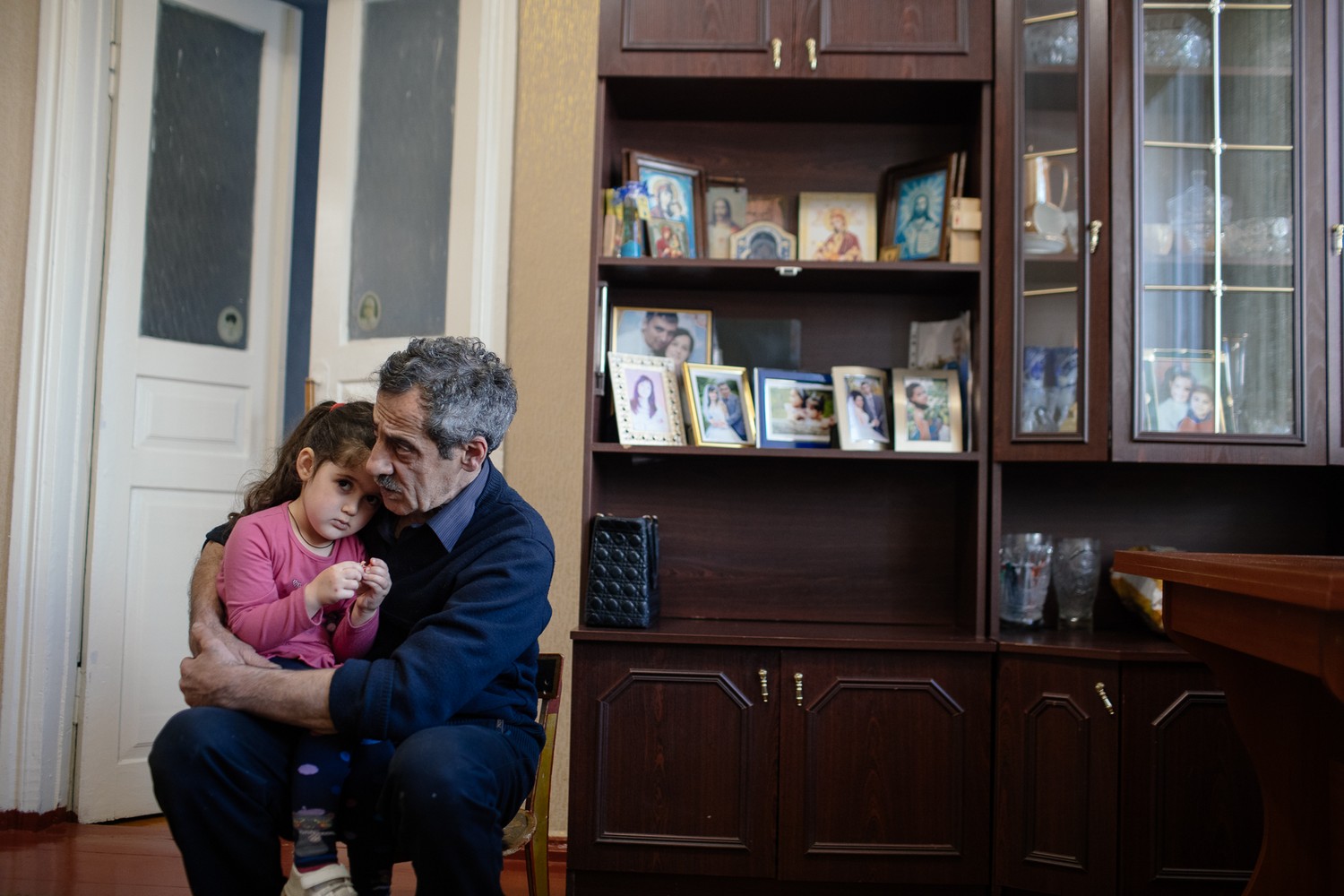
Translated by Ali Kinsella.
[This publication was created with support of the Royal Norwegian Embassy in Ukraine. The views and opinions expressed in this publication are those of the authors and do not necessarily reflect the official position of the Norwegian government].
Have read to the end! What's next?
Next is a small request.
Building media in Ukraine is not an easy task. It requires special experience, knowledge and special resources. Literary reportage is also one of the most expensive genres of journalism. That's why we need your support.
We have no investors or "friendly politicians" - we’ve always been independent. The only dependence we would like to have is dependence on educated and caring readers. We invite you to support us on Patreon, so we could create more valuable things with your help.
Reports130
More